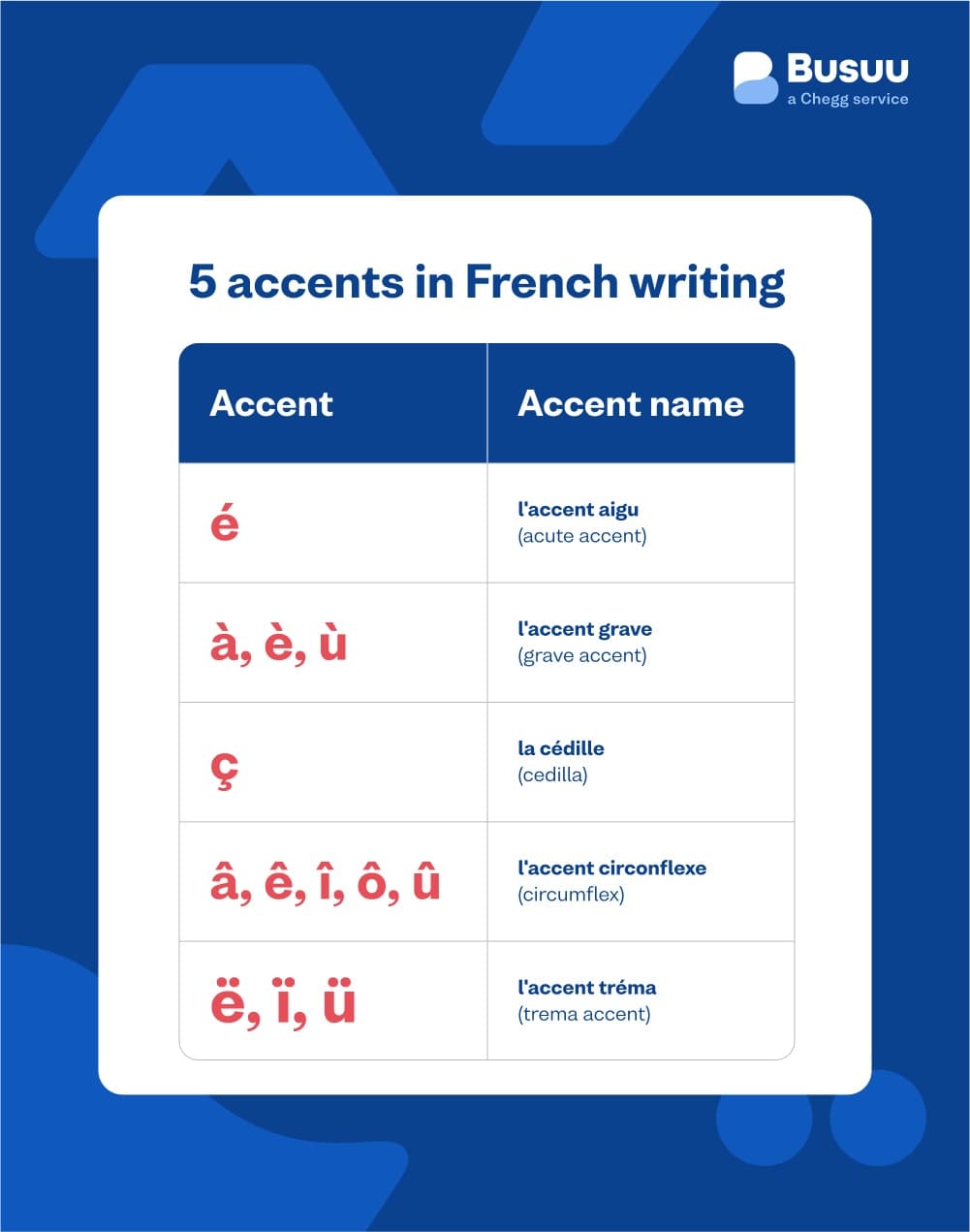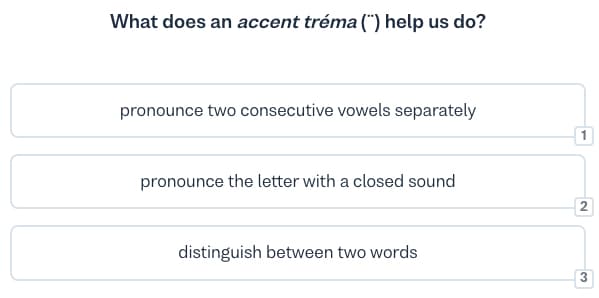I want to learn...
Whether you’re learning French for the first time and need help with French accent marks, or simply writing in French and realizing you’re being slowed down by those pesky – but necessary – little symbols, you’re in the right place. We’ll teach you the 5 French accent marks and how to type them on both Mac and PC.
First, let’s take a look at the accent marks themselves.
The 5 accents in French writing are:
l'accent aigu (acute accent) – é
l'accent grave (grave accent) – à, è, ù
la cédille (cedilla) – ç
l'accent circonflexe (circumflex) – â, ê, î, ô, û
l'accent tréma (trema) – ë, ï, ü

Each of the 5 French accent marks, explained
1.L’accent aigu (acute accent)
Looks like: é
About: The accent aigu is primarily used to tell the reader how an ‘e’ should be pronounced. (It’s the only French accent that can only be paired with one vowel, and that vowel is ‘e.’)
See, in French, like in English, there are many ways that the letter ‘e’ can be pronounced, depending on context. However, when you see this accent, you know exactly how that ‘e’ is pronounced. An ‘é’ is always pronounced like the name of the letter “a” (rhymes with say or bay) – but with a little twist.
In English, we say “ay” with a diphthong, meaning we technically say two vowels in a row. The French é is more like “ay” but if you cut off the sound halfway through, just before you get to the ‘y’.
You’ll see ‘é’ used a lot when forming the past participle, as in the passé composé and other French verb tenses. In that case, the ‘é’ helps differentiate between past and present tense verbs in both written and spoken French.
Think je pense versus j’ai pensé – without the accent, they’d be harder to tell apart.
For our linguistics fans: An ‘é’ near the beginning of a word sometimes serves an additional purpose. It can be a linguistic marker that the root word in Latin or Old French had an ‘s’ in it that was dropped somewhere along the line, as in étudier (to study) and établir (to establish). But the pronunciation aspect remains the same!
2.L’accent grave (grave accent)
Looks like: à, è, ù
About: The accent grave can be used with the vowels ‘a,’ ‘e,’ and ‘u.’ Its function depends on which vowel it’s paired with.
E accent grave
When an ‘e’ gets the accent grave, as with the accent aigu, its primary use is to indicate pronunciation.
An ‘è’ is always pronounced “eh”, as in “get” or “ebb”.
E accent grave also appears in certain verb conjugations, helping to differentiate between tenses as well as providing a pronunciation guide.
A and U accent grave
With a and u on the other hand, the accent grave is used to differentiate between words that otherwise look and sound the same.
In fact, ù appears in only one word: où (meaning “where or when”), and is used to differentiate between où and ou (meaning “or”).
A with an accent grave appears in a handful of French words, including:
là (there) – differentiated from la (the) à (to) – differentiated from a (has, as in il a) çà (here, as in çà et là) – differentiated from ça (this)
And in a few words without homonyms, like voilà and déjà, where it perseveres because they were originally contractions of words that use the accent grave.
3.La cédille (cedilla)
Looks like: ç
About: The cedilla or la cédille is the only accent on c in French. It is used to indicate that the ‘c’ in question is pronounced like an ‘s’, as in français and garçon.
The cedilla appears only before the vowels ‘a,’ ‘o,’ and ‘u.’ That’s because a ‘c’ before an ‘e’ or ‘i’ is pronounced like an ‘s’ anyway, whereas before an ‘a,’ ‘o,’ or ‘u,’ without the cedilla, it makes a ‘k’ sound.
4.L’accent circonflexe (circumflex)
Looks like: â, ê, î, ô, û
About: The circumflex accent is sort of like the culmination of everything we’ve learned so far. That’s because l’accent circonflexe can be used:
to indicate pronunciation
to differentiate between homonyms
as a linguistic marker showing a historical spelling change
Fun, right? Let’s take a closer look.
In pronunciation
When used over a, e, and o, the accent circonflexe indicates pronunciation:
 is pronounced “ahh”, as in “mama” or “ahh, what a lovely vista.”
Ê is pronounced just like e with the accent grave– like “eh” as in “get” or “Bette Midler.”
Ô is pronounced like “oh”, as in “boat” or “oh wow, is that Bette Midler?”
Over i and u, the circumflex does not indicate pronunciation with one exception: jeûne, (meaning to fast, dietarily speaking), where both vowels are pronounced individually – as opposed to the similar jeune (meaning young) where the vowels combine to create the French “euh” sound.
For differentiation
The circumflex can, like the accent grave, be used to simply differentiate pairs of otherwise identically spelled words with different meanings. This is primarily used for û. A few examples include sûr, mûr, and dû.
To document changes
And lastly, like the accent aigu, the accent circonflexe may indicate that there used to be an ‘s’ in the word in question which has been dropped in French spelling and pronunciation over time. Think forêt (forest), hôpital (hospital), and août (August).
5.L’accent tréma (trema)
Looks like: ë, ï, ü
About: Last, but certainly not least, we have the accent tréma. While this looks like an umlaut, it’s (interestingly!) actually unrelated, and developed separately.
Instead of telling you how something is pronounced, the trema tells you that it is pronounced at all.
It’s used in French, especially in names, to tell you to pronounce both vowels (for example, like Zoë, Noël, and Taïwan). It’s also used when a word ending in -gu (like aigu!) is made feminine, to tell you that’s what’s happened and to pronounce the end of the word. So aigu becomes not aigue but aigüe. That’s because the ending -gue in French usually skips pronunciation of both vowels (think vogue or langue).
And those are the 5 accent marks!
Now let’s talk about how to type them.
How to type accents in French
Typing accents in French is easy. All you need is the right combo of keys and you can forget about copy-pasting and endless googling. Fortunately, we’ve compiled all the necessary info you need to type all the accent marks in French quickly and easily.
Mac
Here’s how to type the French accents on an Apple computer. For all but la cédille, you’ll need to hold down Option and the first key together, then release and type the vowel of your choice to have it appear under the accent.
L'accent aigu: Option (alt) + e, then vowel (é)
L'accent grave: Option (alt) + `, then vowel (à, è, ù)
La cédille: Option (alt) + c/C (ç)
L'accent circonflexe: Option (alt) + i, then vowel (â, ê, î, ô, û)
L'accent tréma: Option (alt) + u, then vowel (ë, ï, ü)

PC
Here’s how to type French accents on a PC.
L'accent aigu: Ctrl + ‘ (apostrophe) + vowel (é)
L'accent grave: Ctrl + ` (accent grave) + vowel (à, è, ù)
La cédille: Ctrl + , (comma) + c/C (ç)
L'accent circonflexe: Ctrl + Shift + ^ (caret) + vowel (â, ê, î, ô, û)
L'accent tréma: Ctrl + Shift + : (colon) + vowel (ë, ï, ü)
And now you know all about French accent marks
Who knew there was so much to accent marks? Armed with all this knowledge, you can speed up your typing and improve your French pronunciation. But don’t stop here! You can keep learning and practicing French with Busuu’s free online courses and learning resources.
Newlanguages


